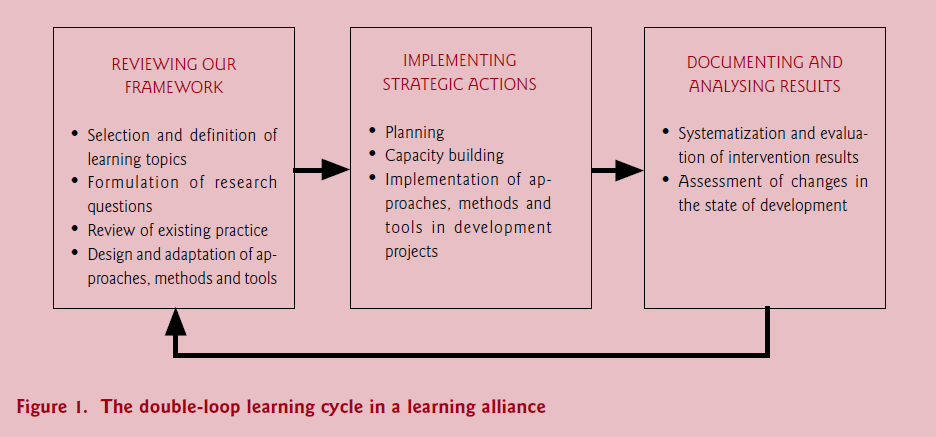Learning alliances involve a structured partnership between two or more organisations with the aim of working together to build and share knowledge around topics of mutual interest.
Examples
The Learning Alliances approach was used by the International Center for Tropical Agriculture (CIAT), an international research institute based in Cali, Colombia, as a way for generating knowledge and fostering innovation processes. The authors indicated that it can be used to "strengthen capacities, generate and document development outcomes, identify future research needs or areas for collaboration, and inform public and private sector policy decisions" (Lundy, Gottret and Ashby, 2005).
CIAT first experimented with this approach in 2000 in collaboration with CARE Nicaragua and eight local partners in 10 municipalities. From there the idea moved to eastern Africa, where a six-nation learning alliance was established with the East Africa regional office of Catholic Relief Services (CRS). These two experiences constitute a first phase of work, where the basic concepts of learning alliances were developed, tools were tested and promising initial results were achieved. More information can be found on the ILAC Brief attached.
Key principles for successful learning alliances
- Clear objectives (what does each organization bring to the alliance?)
- Shared responsibilities, costs and credit (since it seeks to benefit all, responsibilities should be shared)
- Outputs as inputs (outputs are used as inputs in the process of rural innovation)
- Differentiated learning mechanisms (more than one learning mechanism is need, as participants have different needs; e.g. participatory monitoring and evaluation, innovation histories, conventional impact assessment)
- Long-term, trust-based relationships (it takes time to influence and understand change)
How CIAT implemented Learning Alliances
CIAT implemented the following steps:
- Identify and convene partner organizations with an interest in rural enterprise development
- Develop clear objectives, roles and responsibilities for the learning alliance
- Define specific topics of interest based on partner needs and priorities
- Implement a double-loop learning cycle for each topic of interest
- Share results among researchers, practitioners and policymakers

Advice for using this method
Challenges for learning alliances include:
- Partner and participant selection
- Process facilitation and coordination
- Funding
- Linking learning across levels
Resources
Sources
Lundy, M., Gottret, M.V. and Ashby, J. (2005) Learning Alliances: An approach for building multistakeholder innovation systems ILAC Brief No. 8. Rome, Institutional Learning and Change (ILAC) Initiative. https://web.archive.org/web/20150423174858/http://www.cgiar-ilac.org/files/ILAC_Brief08_alliances_0.pdf (archived link)
Expand to view all resources related to 'Learning alliances'
'Learning alliances' is referenced in:
Framework/Guide
- Rainbow Framework :